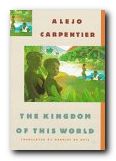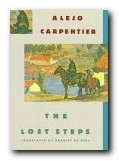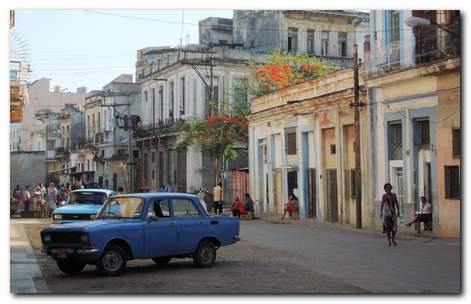tutorial, commentary, study resources, plot, and web links
The Chase (El Acoso) was first published in 1956 whilst Alejo Carpentier was living in Venezuela, in self-imposed exile from what he regarded as his native Cuba, which was under the dictatorship of General Batista at the time. Although neither the fictional country nor the city is named in the novel, most commentators accept that he captures the spirit (and the terror) of Havana during a period of political persecution and social unrest.
The Chase – critical commentary
Literary style
Carpentier’s literary style is not dissimilar to that of two other modernists, Woolf and Joyce, in seeking to achieve a sense of temporal simultaneity in his prose. He writes about more than one subject and one period in the story at the same time, by switching from one topic or character to another, often within the same sentence.
It is significant that in general he makes very little use of the paragraph, and extensive use of the ellipsis (…) the semicolon, and the dash – as this passage describing the fugitive’s fear in the concert hall demonstrates:
It might be a Sign; my eyes will try to avoid it, looking above it, below it, finally making me dizzy; I must clench my teeth, clench my fists, calm my stomach—calm my stomach—I must stop that running sensation in my guts, that breakdown of my kidneys which sends sweat to my chest; one thrust and another, one jolt and another; I must tighten myself up, cover up the falling apart inside, cover up what’s flowing out of me, boiling out of me; piercing me; I must tighten myself up over the thing that’s drilling and burning, in this immobility to which I am condemned, here, where my head must remain at the same height as every other head.
Carpentier also narrates the fictional past and present simultaneously. The fugitive is trying to escape from his assailants from the very beginning of the novel, but mingled with his thoughts and fears, we are gradually given the account of his past.
He also mixes first and third person narrative modes – third person objective statements recounting the fugitive’s movements and descriptions of the city, and at the same time first-person accounts of his thoughts, fears, and memories.
Structure
Despite the complexities of the narrative and the manner in which the story is delivered, the structure of the novel is quite simple. In Part I, the un-named fugitive arrives at the concert hall, on the run from his assailants. He gives the student ticket seller a fake banknote, which the student then unsuccessfully tries to spend through buying a night with the prostitute Estrella.
The events of Part II take place before those of Part I, and reveal the desperate life of the fugitive as a political agent, an assassin, and a traitor up to that point. He too has been a client of Estrella’s, and is now in fear of his life after betraying his comrades.
Part III of the narrative goes back to the point at which it broke off in Part I, and the story concludes with the student returning from the prostitute, the end of the concert, and the shooting of the fugitive.
There are several neat structural links between the separate parts of the story. When the fugitive gives the fake (or out-of-date) banknote to the ticket seller, the student tries (unsuccessfully) to buy a night with the prostitute Estrella. But we learn later that the fugitive has also been a regular client of Estrella’s, and has had the banknote turned down by her for the same reason earlier on the same day.
Moreover, the ticket seller is a student of music, and the fugitive has previously been a student of architecture before his activities as a political undercover agent. Both music and architecture were favourite subjects of Carpentier himself. He wrote a study of Music in Cuba (1946).
There are other small details which tie the two parts of the story together. In Part I the ticket seller is fascinated by the erotic spectacle of the lady in the fox fur who has removed some undergarment because of the heat. And in Part III when the fugitive is hiding in the concert hall, he too notices the same woman who is a member of the audience.
Novel or novella?
The Chase is sometimes referred to as a novel or a short novel, but in fact it has all the characteristics of the novella in terms of unity of character, place, time, action, and theme.
The whole narrative is concerned with just one character – the un-named fugitive – with the ticket seller and Estrella acting as very incidental characters of secondary importance.
In terms of place, the entire narrative unfolds in the city (of Havana) with no extraneous locations or shifts of scene. And it can be argued that the time or action are even more concentrated. Although Part II of the narrative recounts the background to the fugitive’s desperate life, the real events of the story begin with his abrupt dash to hide in the auditorium (Part I) and end shortly afterwards when the concert ends and he is shot dead. This is a time span of less than the performance of Beethoven’s Eroica Symphony which is being played.
This leaves us with the question of the theme.
What is the theme of the text?
There is normally an expectation that the central character in a novella will be tragic or at least admirable, but the fugitive in The Chase does not seem to qualify for either of these categories. He has been a student of the humanities, but has drifted into violent political activism as a member of the Communist Party. This might still be regarded as heroic in the tyranny of General Batista’s Cuban dictatorship which forms the backdrop to the story, except for two further issues.
The fugitive goes on to betray his colleagues when threatened with torture. This too might be seen as an understandable human weakness, but he also has another guilty secret. He appears to be working as a double agent – because he believes he has the protection of the ‘Exalted Personage’ – presumably a member of the government dictatorship against which the rebels are fighting. From this source he is hoping to obtain an exit visa and money to escape.
When this avenue of relief is closed with the destruction of the Personage’s villa, his personal drama reaches its climax in the cafe when he spots two men who are going to kill him. He believes that these assassins are acting for the rebels, seeking revenge for his betrayal, but they turn out to be police, acting for the government. If there is a tragedy here therefore, it is perhaps the tragedy of a society under the tyranny of a dictatorship, and the lengths to which some of its citizens are driven.
The Chase – study resources
![]() The Chase – at Amazon UK – (text in English)
The Chase – at Amazon UK – (text in English)
![]() El Acoso – at Amazon UK – (text in Spanish)
El Acoso – at Amazon UK – (text in Spanish)
![]() The Chase ) – at Amazon US – (text in English
The Chase ) – at Amazon US – (text in English
![]() El Acoso – at Amazon US – (text in Spanish)
El Acoso – at Amazon US – (text in Spanish)
The Chase – plot summary
Part I
In an un-named Latin-American city (Havana), a young music student is working as a ticket-seller in a concert hall, meanwhile reading a biography of Beethoven. When a fugitive enters the hall pursued by two men, he leaves a large banknote at the ticket office.
The fugitive hides in the audience, consumed by a terror-stricken panic that he will be discovered. He feels oppressed by the music, and invokes his religious faith to support himself.
The music student is with the prostitute Estrella, who complains of an ‘Inquisition’ by the authorities. When he offers her the banknote, it turns out to be worthless, so she throws him out. He thinks back to a childhood sweetheart and feels humiliated by his lack of worldly success, finally returning to the concert hall just before the performance ends.
Part II
The fugitive is hiding out in an old house with a belvedere, protected by an old woman who was once his nurse. He is waiting for details of an ‘Arrangement’.
He has been a student of architecture and also a member of the Communist Party. He is now disciplining himself for some task that awaits him. He is trying desperately to battle against hunger.
He endures four days without eating, and fantasises about eating wood and boiled leather. But he remains in hiding, behind a barricaded door.
He finds logical reasons for justifying his intense religious beliefs, and hears music coming from an adjacent building, then discovers that the old woman has died. He is fearful of going back into society and being recognised.
He attends the wake of the old woman, then goes back fearfully into the streets, making his way to the house of Estrella the prostitute.
He spends the night with Estrella, but feels slighted by her. She in her turn, and despite a certain pride in herself, feels degraded by her profession.
He gives instructions to Estrella to collect information from an important person on the other side of the city. But she returns telling him that the banknote he has given her is a fake. When an argument develops outside, the fugitive escapes by a rear exit.
The fugitive makes his way in the shadows towards a house of rendezvous. He has assassinated a politician with an exploding book, and has recently been in prison where he has confessed and betrayed his accomplices. He wants his government contact to provide him with an exit visa and some money.
He thinks back to his desperate actions as a revolutionary, during which time he has taken part in a tribunal which resulted in a vote to execute one of his comrades.
He has participated as an under-cover agent and committed acts of political violence that have left him feeling ashamed. Arriving at the house of his high office protector, he finds it in ruins.
He has also been part of an assassination squad and graduated in the ‘bureaucracy of terror’. But after the exploding book incident claimed its two victims he has been arrested and threatened with torture – at which point he has capitulated and betrayed his colleagues.
He finds refuge in a church where a marriage is taking place, and hopes to find spiritual comfort by confessing his sins to a priest. But when the ceremony is over, the parish priest turns him out and tells him to come back next day.
Trying to return to the funeral wake as his only place of refuge, he is intercepted by two rabid student fans of violence. Then, as a storm begins, he spots two men with guns watching him, and narrowly escapes them into the concert hall.
Part III
He cowers in the hall, thinking that his former colleagues are waiting for him outside, ready to execute him for his betrayals. He finally decides that the safest thing will be to stay behind, hiding in the hall when the concert is over.
The student ticket collector is in the act of closing up when two policemen stay on after the performance and shoot the fugitive where he is hiding.
Alejo Carpentier – other works
 The Kingdom of This World is a marvelously compressed account of the slave uprising and first revolution of the early nineteenth century in San Domingo – now Haiti. Carpentier uses ‘magical realism’, long before it became fashionable, to depict the contradictions between political reality and religious or mythical beliefs. The story passes rapidly in a series of vivid scenes from the early unsuccessful uprising led by Macandal, then Bouckman who led Haiti in its fight for independence from France, and finally to Henri Christophe the revolutionary leader who later became Emperor of Haiti, and who built Sans Souci and La Ferrière Citadel.
The Kingdom of This World is a marvelously compressed account of the slave uprising and first revolution of the early nineteenth century in San Domingo – now Haiti. Carpentier uses ‘magical realism’, long before it became fashionable, to depict the contradictions between political reality and religious or mythical beliefs. The story passes rapidly in a series of vivid scenes from the early unsuccessful uprising led by Macandal, then Bouckman who led Haiti in its fight for independence from France, and finally to Henri Christophe the revolutionary leader who later became Emperor of Haiti, and who built Sans Souci and La Ferrière Citadel.
![]() Buy the book at Amazon UK
Buy the book at Amazon UK
![]() Buy the book at Amazon US
Buy the book at Amazon US
 The Lost Steps (1953) is a story told twice. A disillusioned north-American musicologist flees his empty existence in New York City. He takes a journey with his mistress to one of the few remaining areas of the world not yet touched by civilization – the upper reaches of a great South American river (which we take to be the Amazon). The novel describes his search, his adventures, the revival of his creative powers, and the remarkable decision he makes about his life in a village that seems to be truly outside history. This novel offers a wonderful evocations of Latin America from the founder of ‘Magical Realism’.
The Lost Steps (1953) is a story told twice. A disillusioned north-American musicologist flees his empty existence in New York City. He takes a journey with his mistress to one of the few remaining areas of the world not yet touched by civilization – the upper reaches of a great South American river (which we take to be the Amazon). The novel describes his search, his adventures, the revival of his creative powers, and the remarkable decision he makes about his life in a village that seems to be truly outside history. This novel offers a wonderful evocations of Latin America from the founder of ‘Magical Realism’.
![]() Buy the book at Amazon UK
Buy the book at Amazon UK
![]() Buy the book at Amazon US
Buy the book at Amazon US
Alejo Carpentier weblinks
Carpentier at Wikipedia
Background, biography, magical realism, major works, literary style, further reading
Carpentier at Amazon UK
Novels, criticism, and interviews – in Spanish and English
The Kingdom of this World
Lecture by Rod Marsh – University of Cambridge
Carpentier at Internet Movie Database
Films and TV movies made from his novels
Carpentier in Depth
Spanish video documentary and interview with Carpentier (1977)
© Roy Johnson 2014
More on Alejo Carpentier
More on the novella
More on literary studies
More on short stories
